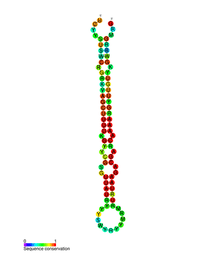miR-208
miR-208 is a family of microRNA precursors found in animals, including humans. The ~22 nucleotide mature miRNA sequence is excised from the precursor hairpin by the enzyme Dicer.[1] This sequence then associates with RISC which effects RNA interference.[2]
| miR-208 | |
|---|---|
 Conserved secondary structure of miR-208 microRNA precursor | |
| Identifiers | |
| Symbol | miR-208 |
| Alt. Symbols | MIR208 |
| Rfam | RF00749 |
| miRBase | MI0000251 |
| miRBase family | MIPF0000178 |
| NCBI Gene | 406990 |
| HGNC | 31585 |
| OMIM | 611116 |
| RefSeq | NR_029595 |
| Other data | |
| RNA type | miRNA |
| Domain(s) | Metazoa |
| GO | 0035195 |
| SO | 0001244 |
| Locus | Chr. 14 q11.2 |
| PDB structures | PDBe |
In humans, the gene for miR-208 is located in an intron of MYH7.[3]
Function
miR-208 has been deemed a "myomiR"[3] as it is specifically expressed, or found at much higher levels, in cardiac tissue. Other myomiRs include miR-1 and miR-133.[3] miR-208 is thought to be dysregulated in various cardiovascular diseases.[4][5]
miR-208 functions in cardiomyocytes regulating the production of the myosin heavy chain during development.[3] It also responds to stress and forms part of a hormonal signalling cascade in cardiac cells.[6]
Applications
A preliminary study has shown a potential use in the prognosis of dilated cardiomyopathy.[7] Another application has been suggested as using plasma concentration of miR-208 as a biomarker of damaged cardiac muscle cells.[8]
References
- Ambros V (December 2001). "microRNAs: tiny regulators with great potential". Cell. 107 (7): 823–6. doi:10.1016/S0092-8674(01)00616-X. PMID 11779458.
- Gregory RI, Chendrimada TP, Cooch N, Shiekhattar R (November 2005). "Human RISC couples microRNA biogenesis and posttranscriptional gene silencing". Cell. 123 (4): 631–40. doi:10.1016/j.cell.2005.10.022. PMID 16271387.
- Malizia AP, Wang DZ (Mar–Apr 2011). "MicroRNAs in cardiomyocyte development". Wiley Interdisciplinary Reviews: Systems Biology and Medicine. 3 (2): 183–90. doi:10.1002/wsbm.111. PMC 3058499. PMID 21305703.
- Cai B, Pan Z, Lu Y (2010). "The roles of microRNAs in heart diseases: a novel important regulator". Current Medicinal Chemistry. 17 (5): 407–11. doi:10.2174/092986710790226129. PMID 20015039.(subscription required)
- Han M, Toli J, Abdellatif M (May 2011). "MicroRNAs in the cardiovascular system". Current Opinion in Cardiology. 26 (3): 181–9. doi:10.1097/HCO.0b013e328345983d. PMID 21464712.
- van Rooij E, Sutherland LB, Qi X, Richardson JA, Hill J, Olson EN (April 2007). "Control of stress-dependent cardiac growth and gene expression by a microRNA". Science. 316 (5824): 575–9. doi:10.1126/science.1139089. PMID 17379774.
- Satoh M, Minami Y, Takahashi Y, Tabuchi T, Nakamura M (May 2010). "Expression of microRNA-208 is associated with adverse clinical outcomes in human dilated cardiomyopathy". Journal of Cardiac Failure. 16 (5): 404–10. doi:10.1016/j.cardfail.2010.01.002. PMID 20447577.
- Ji X, Takahashi R, Hiura Y, Hirokawa G, Fukushima Y, Iwai N (November 2009). "Plasma miR-208 as a biomarker of myocardial injury". Clinical Chemistry. 55 (11): 1944–9. doi:10.1373/clinchem.2009.125310. PMID 19696117.
Further reading
- Kukreja RC, Yin C, Salloum FN (October 2011). "MicroRNAs: new players in cardiac injury and protection". Molecular Pharmacology. 80 (4): 558–64. doi:10.1124/mol.111.073528. PMC 3187527. PMID 21737570.